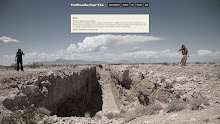
We routed an eight foot piece of plywood, wet it down, and were completely scared of breaking it as we fit it inside the diorama today. Unfortunately, the wood we bought was too fragile to bend the opposite way so we have a lot of filling and sanding to do before we get a smooth surface.

It looked so empty inside without anything so Chet finally took the portrait of us sitting in it. We are guessing this thing will weigh a couple hundred pounds (sans us) once we are finished.

Here we are covered in wood dust. One day here soon we will be at the point where we are working on the interior. Until then there is joint compounding and sanding to do. I have to find elevations, longitudes, and latitudes for these locations as well. I will admit to being a complete dork by just putting a book called
Terrain Modelling on interlibrary loan. It's amazing how many volumes there are on building military dioramas. None on scale models of earth art!
Of course this is very reminiscent of the
Menil Collection's scale model which is up there with one of my favorite things.

... though I was never truly happy with Vik Muniz's interpretation of it in his series
Model Pictures.

Published in
SPOT magazine, 2002 written by yours truly:
"The Menil Collection commissioned Muniz to create a piece specifically for FotoFest 2002 based on the artwork in the collection. Muniz discovered the Menil model on a site visit and was immediately drawn to the exact rendering of every sculpture, painting, and icon in the foundation’s collection. Unlike many institutions who use the color copier to reproduce art work, the pieces in the Menil model were hand crafted by Mark Flood, Doug Laguarta, and David Warren. Each room is represented in miniature proportion; it is a fascinating object borne of meticulous execution, used to visualize exhibitions before installation. It is no wonder that Muniz was drawn to its scale and detailed craft.
After photographing a number of the maquettes, Muniz decided to narrow the field and use only Surrealist art works. Since the Menil is famous for its Surrealism collection, this was a logical decision. In an interview with Matthew Drutt, Muniz also revealed that he selected well known Surrealist images because it is easier to deceive the viewers who enter the exhibition with preconceived ideas about the original work of art. The majority of the objects in Model Pictures are reproductions of the work of René Magritte and Man Ray, with token representations from Max Ernst, Pablo Picasso, Gustave Doré, Alberto Giacometti, Odilon Redon, and Giorgio de Chirico. The resulting exhibition includes twenty maquettes photographically enlarged to the scale of the original paintings. A section of the original model resides in the center of the installation.
The rephotographed reproductions are hardly accurate renditions of the original artwork. Detail is lost in the process creating a quality similar to a xerox of a xerox of a xerox. The inherent imperfections are magnified, emphasizing the dings, smudges, and unblended shifts in color. Magritte’s
Le chant des sirènes, looks as if it was rendered in crayon; a rubbing over pavement to create the texture of the background sky. There is a subtle clash in surfaces – the smooth, nonreflective photographic paper contrasts with the textured quality, which is heightened in the reproductive process. The photographs also incorporate the original and sometimes overly elaborate frames, creating a false illusion of depth on a two-dimensional plane....
....Absurdity and humor are essential components in Muniz’s work, as witnessed by his painted silhouettes of bovines on white cows and two portraits of the Mona Lisa, one in peanut butter and the other in jelly. These two elements, along with the artist’s laborious process, are absent in the far more serious Model Pictures. He relies on found objects, merely documenting someone else’s reproduction of art rather than creating the work himself. He depends on a fascinating, existing object to carry the installation, but ultimately, it is not taken far enough..."















.jpg)



































